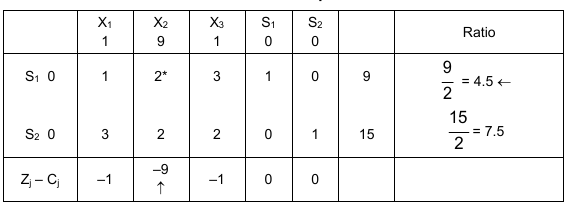Subject to x1 + 2x2 + 3x3 ≤ 9
3x1 + 2x2 + 2x3 ≤ 15
x1, x2, x3 ≥ 0
Rewriting in the standard form
Maximise z = x1 + 9x2 + x3 + 0.S1 + 0.S2
Subject to the conditions
x1 + 2x2 + 3x3 + S1 = 9
3x1 + 2x2 + 2x3 + S2 = 15
x1, x2, x3, S1, S2 ≥ 0
Where S1 and S2 are the slack variables.
Solution:
The initial basic solution is x1, x2, x3 =0, S1 = 9, S2 = 15

Table 1 depicts the initial simplex table.

Work column* – pivot element
S1 – outgoing variable, x2 – incoming variable
Since the three Zj – Cj are negative, the solution is not optimal. Choose the maximum negative value that is –9. The corresponding column vector x2 enters the basis replacing S1, since ratio is at minimum. You can use the elementary row operations to reduce the pivot element to 1 and other elements of work column to zero.
Divide row 1 with the key element 2 and get the new row. Now make all other elements in the key column zero.
First iteration – The variable x2 becomes a basic variable replacing S1 and you obtain the table 2.

Since all the elements of the last row are non-negative, the optimal solution is obtained. The maximum value of the objective function Z is 81/ 2, achieved for x2= 9/2 S2 = 6, are the basic variables (refer the shaded column of table 2.). All other variables are non-basic.
Total Views: 21
